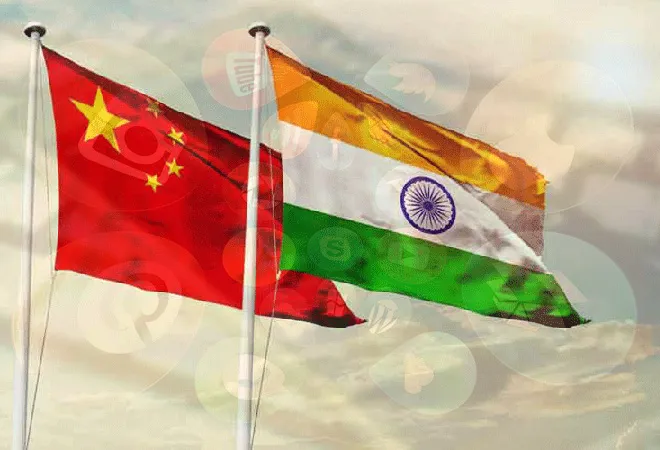
China-India relations made limited progress in the year 2022. Entering the New Year, as we deliberate upon how this critical relationship is going to pan out in the coming months, we must take special note of the current Chinese discourse on India. By analysing Chinese language media, Chinese internet and social media space, this paper finds out three key issues presently dominating China’s internal debates and discussions on India, which, in a way, is also shaping the country’s overall attitude and policies towards India.
1. Concern over losing the ‘No. 1’ spot
Chinese analysts seem to be somewhat
alarmed by the news of India’s population surpassing that of China’s in the next few months. Various commentaries on the Chinese internet note with sheer concern that India will become the most populous country in the world, and the number of young people will exceed that of China’s by about 50 percent. The Chinese apprehensions are based on three factors: First, it is being argued that the growing population will make India's internal market large enough, with huge domestic demand to compensate for the ongoing anti-globalisation trend worldwide—something the Chinese economy has been striving to achieve for a long time but with limited success. Secondly, many Chinese observers find the situation in today’s India (where the vast majority of better-educated post-90s Indians are ready to join the workforce) similar to that of China in the early 2000s when the post-80s generation entered the labour force in large numbers, eventually leading to the economic take-off of China. In the next 10 years, they argue, India might also be able to replicate China’s economic success to a certain extent. Last but not the least, it is argued that the penetration and popularity of mobile internet in India, is way higher than that in China in the 2000s, which, the Chinese side believes, can further propel an information technology-driven economic development in India, that might outperform China’s development experience, in terms of quality and pace.
Various commentaries on the Chinese internet note with sheer concern that India will become the most populous country in the world, and the number of young people will exceed that of China’s by about 50 percent.
In comparison, China is understood to be ageing faster and having fewer births. The number of working-age people (15-64 years old) has continued to decline since 2012 and with it, China’s growth rates. After 2025, the working-age population in China is expected to decline by 0.5 percent to 10 percent per year. In the following years, China is also expected to become the country with the largest ageing population after Japan. Many believe the ageing population to become the Achilles'
heel of China's economy, negatively impacting its innovation and entrepreneurship capability
Indeed, there are many factors that still restrict India from reaping the demographic dividend (such as low efficiency of India's democratic politics, social tension, corruption, backward infrastructure construction, low labour-force participation, etc.) and there are also many ways China is attempting to compensate for its population problem (supportive government policies, improving labour productivity, transforming from a country rich in human resources to a country rich in
human capital, etc.). Despite all that, Chinese observers believe that China should not underestimate an otherwise adversary, that is India’s potential for accelerated development in the coming years and prepare for a situation where it emerges as the world's second or third-largest economy, challenging China’s primacy in Asia and threatening its national security.
2. Rise of Indian manufacturing: Challenges and risks
There are lot of discussions on the Chinese internet about the challenges posed to China by the post-COVID recovery of the Indian economy and the rise of its manufacturing sector. Be it the positive assessment of the future course of the Indian economy made by renowned economist and Nobel Laureate Michael Spence, or Morgan Stanley's Chief Asia Economist, Chetan Ahya, predicting India’s emergence as the third-largest economy by 2027 or international media’s coverage of the resilience of the Indian stock market and international capital’s growing interest in India – all these news emerged as major talk points within Chinese strategic circles. Various
commentaries note with concern how Apple Inc. has accelerated the withdrawal of its production lines from China and gradually shifting its manufacturing centre to India. Not just Apple or Samsung, it is also
noted that many Chinese companies in the electronics space, new energy vehicle space, etc are keen on entering the Indian market and take advantage of the Indian government’s various policy incentives.
However, sections within the Chinese strategic community have been
cautioning against the Modi government's current manufacturing/industrial policy of “use”, “catch up”, “expel” “replace”, particularly vis-à-vis the Chinese companies. India under Modi, they say, is not just satisfied forcing Chinese enterprises to “make in India” and “export from India”, but wants to build a complete manufacturing industry in India. For instance, in the mobile phone manufacturing space, India, they argue, is “forcing” Chinese mobile phone companies to transfer final assembly lines to India, either coercing or luring them to transfer upstream suppliers of supporting tools, parts, components to India and then complementing these industrial sectors with high value-added products like chips and screen displays, thereby, setting up a complete industrial ecosystem for mobile phone manufacturing in India. This is where, they say, India is different from Vietnam or Bangladesh, who are content with just strengthening their production and processing bases, but India wants more, it wants to grab the entire value chain from China.
Not just Apple or Samsung, it is also noted that many Chinese companies in the electronics space, new energy vehicle space, etc are keen on entering the Indian market and take advantage of the Indian government’s various policy incentives.
Under such circumstances, questions are doing rounds on the Chinese internet if following Apple’s example, other foreign/ domestic manufacturing companies will move their production lines out of China? Can India really replace China as a world manufacturing hub? Can India replace China to lead the Asian economy? Such has been the paranoia among the Chinese side that a few days back a post went viral on the Chinese internet highlighting crowds of people flocking the Delhi Airport in the middle of the night. The phenomenon was interpreted by Chinese netizens as “Europeans and Americans frantically running to India to start companies and invest”.
No wonder some Chinese strategists have been urging the Chinese government to not just focus on the trade/tech war between China and the US but also
pay greater attention to the “economic offensive” launched by India vis-á-vis China – particularly the risks and challenges arising from the rise of India’s manufacturing industry and in turn take effective measures to safeguard China’s critical economic and geopolitical interests.
3. Adding the United States (US) power to the China-India game
The other issue that the Chinese side seems to be particularly prickly about is “India
adding the US power to the China-India game” to neutralise China’s existing economic and military superiority vis-à-vis India. For instance, as the Indian and Chinese troops clashed on 9 December 2022 at LAC in the Yangtse area near Tawang in Arunachal Pradesh, the dominant discourse in China was that the joint US-India military exercise conducted a few days earlier in the Himalayas, only 100 km away from the LAC, has been the main trigger or the “fuse” behind the recent clash. From
Liu Zongyi, senior fellow and secretary general of the South Asia and China Centre, Shanghai Institutes for International Studies (SIIS) to
Wang Shida, deputy director of the South Asia Institute of the China Institutes of Contemporary International Relations to umpteen number of articles in the Chinese internet by anonymous commentators have highlighted a direct connection between the two developments. It appears from the Chinese discussions that the said exercise might have played an important role in pressurising China, which has been reluctant to hold further talks on disengagement since July 2022 to approach the negotiating table. Meanwhile, the attempted ingress in Arunachal Pradesh might be an attempt from the Chinese side towards gaining some on-ground leverage at the LAC, that can be used as additional bargaining chips during the negotiation process.
Chinese observers note how China had originally planned to use the interdependence between the Chinese and American economy to carry out the transformation/ upgradation of its manufacturing industry.
However, it is not just India-US military cooperation that the Chinese side is concerned about. China seems to be most perturbed by, what it perceives as, the convergence of interest between the US and India in reorganising/realigning global supply chains. Chinese observers
note how China had originally planned to use the interdependence between the Chinese and American economy to carry out the transformation/ upgradation of its manufacturing industry. While on the other hand, it simultaneously sought to exploit the vast Indian market under its Belt and Road plans to develop and industrialise (through transfer of low-end industries from China’s industrially advanced eastern provinces) its lagging inland provinces, thereby ensuring China’s economic rise to be more balanced, long-term, self-sustaining, and unbeatable. However, the script went awry midway, as the US refused to let China carry out its industrial upgradation process smoothly, and initiated “the trade and technology war”; on the other hand, India refused to cooperate and integrate the Indian economy with that of China under the BRI, RCEP or other China-led economic initiatives. Thus, the Chinese ire over both the US and India, whom it accuses of engaging in a “de-Sinicisation” conspiracy, seeking to exclude China from the global industrial chain and thereby dividing up the economic benefits between themselves, that originally belonged to China
Overall, it is interesting to note that at a time when all eyes in India are fixed on the volatile border, the Chinese side seems to be of the opinion that the real conflict between China and India is not at the LAC but in the development competition, particularly in India’s ambition to catch up with China.
The views expressed above belong to the author(s). ORF research and analyses now available on Telegram! Click here to access our curated content — blogs, longforms and interviews.



 China-India relations made limited progress in the year 2022. Entering the New Year, as we deliberate upon how this critical relationship is going to pan out in the coming months, we must take special note of the current Chinese discourse on India. By analysing Chinese language media, Chinese internet and social media space, this paper finds out three key issues presently dominating China’s internal debates and discussions on India, which, in a way, is also shaping the country’s overall attitude and policies towards India.
China-India relations made limited progress in the year 2022. Entering the New Year, as we deliberate upon how this critical relationship is going to pan out in the coming months, we must take special note of the current Chinese discourse on India. By analysing Chinese language media, Chinese internet and social media space, this paper finds out three key issues presently dominating China’s internal debates and discussions on India, which, in a way, is also shaping the country’s overall attitude and policies towards India.
 PREV
PREV


